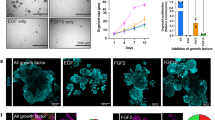Abstract
THE mammary gland of the pig has normally two primary ducts which open separately on the surface of the nipple. Embryologically, the two ducts proliferate from the base of a cone-shaped depression of the stratum germinativum known as the mammary pocket or mammary bud. A similar depression or epithelial ingrowth, variable in depth, surrounds the nipple at its juncture with the body wall. Among several f” tal glands sectioned, a few cases of aberrant ducts, similar histologically to the primary ducts, were noticed to have sprouted from the same relative position to the apex of the epithelial ingrowth at the base of the nipple as the primary ducts do to the apex of the mammary pocket (Fig. 1).
This is a preview of subscription content, access via your institution
Access options
Subscribe to this journal
Receive 51 print issues and online access
$199.00 per year
only $3.90 per issue
Buy this article
- Purchase on Springer Link
- Instant access to full article PDF
Prices may be subject to local taxes which are calculated during checkout
Similar content being viewed by others
References
Arch. Entw. Mech. Org., 100, 599.
J. Exp. Biol., 13, 86.
” The Mammary Apparatus of the Mammalia” (Methuen).
Author information
Authors and Affiliations
Rights and permissions
About this article
Cite this article
DEAKIN, A. Induction of Mammary Ducts. Nature 137, 619–620 (1936). https://doi.org/10.1038/137619b0
Issue Date:
DOI: https://doi.org/10.1038/137619b0
Comments
By submitting a comment you agree to abide by our Terms and Community Guidelines. If you find something abusive or that does not comply with our terms or guidelines please flag it as inappropriate.



